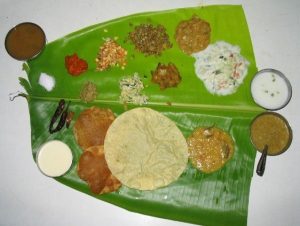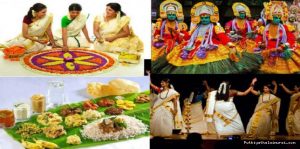The Indian Thali which is called plate in English is an ancient way to present, enjoy and digest food in a unique way. It is believed that Thali is a temple innovation; the way it is presented in a certain way as offering to God. In Maharashtrian, South Indian in temples such as Tirupati Balaji, Meenaxi temple at Madurai, in Goan temple tradition there are people who are specialized in arrangement of cooked food in particular form. But, the best example is of plating seen in the Jagannath Temple in Puri, 56 food items offered to Lord Jagannath which is referred as “Chappan Bhog”. It consists o f Lord Krishna’s favourite dishes and usually includes cereal, fruits, dry fruits, sweets, drinks, namkeen and pickles in quantities of seven under each category. There is another school of thought which acclaims big extensive plating to affluence of people; the rich and famous serve numerable items in a thali which goes on to show their riches.
f Lord Krishna’s favourite dishes and usually includes cereal, fruits, dry fruits, sweets, drinks, namkeen and pickles in quantities of seven under each category. There is another school of thought which acclaims big extensive plating to affluence of people; the rich and famous serve numerable items in a thali which goes on to show their riches.
Ayurvedic Principal applied: Even today, the Indians food contains an Ayurvedic principal which is based on the food pyramid. Food Pyramid is a triangular nutrition food guide which tells us how much of what food to eat. This pyramid has been in use for decades now. In India we have a food guide pyramid given by the National Institute of Nutrition. In the US, the pyramid has been given by their USDA (United State Department of Agriculture). Even, in parts of Europe, Africa, Americas, Australia and Asia their versions exist.
All of these pyramids and recommendations speak a similar language: more of complex carbohydrates, less of fat and protein, and adequate fruits, vegetables and fibre. Generally speaking, complex carbohydrates come at the bottom of the pyramid, next up are fruits and vegetables, higher up and in lesser quantities are the pulses, dals, dairy foods, and meats. Right on top in the narrowest section contains fats and sweets.
Plating in India was also influenced by vaidyas (royal physicians) and hakims who were employed to evaluate what the king and his men should eat on a regular basis. In most royal courts, the vaid would decide not only the level of spices, but also the seasonal fruits and vegetables.
Every thali consists of pickles and chutneys; because they add flavour and act as a foil to mild dishes and sweet chutneys do the same to spicy dishes and they aid digestion. Most Indian thalis feature palate cleansers. In the Manipuri Chakluk, it’s the cabbage salad. In Uttar Pradesh, it is the kachumber and in Odisha, a small cup of ripened papaya or coconut meat with mint serves the purpose. Palate cleansers help diners experience flavours better and also negate the need to drink water, which hold back digestion during a meal.
One of the jewels of Indian thalis is the Kerala banana leaf sadhya thali which takes into consideration the three biological energies found throughout the human body the vatta, pitta and kapha. According to the classics of Ayurveda, the Charaka Samhita and Susruta-samhita, any food that has been cured and preserved is high on vitamin and antioxidants, and hence, works on the principle that less is more. The best example is the pickles. The pickle making is both science as well as an art.
Seasonal and local food included: Indian thalis are highly seasonal and local. They display indigenous cooking techniques such as steaming, fermenting, grilling, deep frying, baking, smoking, boiling, stirring, peeling, slicing to name a few. The other common thing you will see in a thali is the use of clarified butter or ghee, which is considered to have medicinal properties that help digest food and build immunity while lending a rich aroma to the dish.
Use of hand and no wastage of food: Traditionally, we eat our food using our hand. Therefore, do not ask for spoons and forks while eating. Use only one hand (usually the right one) to eat. The other hand should not touch the plate; it is not to be kept on the table. This hand can be used for re-serving yourself from the main bowls. The original culture of eating is by sitting on the floor to eat. You are not supposed to get up in the middle of a meal. It is considered rude and disrespect of food and the people you are eating with. Most important message is: DO NOT WASTE FOOD. If you are unsure of the quantity of food you want to eat, serve yourself small portions and go for a second round. It is completely okay if you end up serving yourself thrice, but wasting food is out of question.
Food is integral part of culture: According to the distinguished and celebrated mythologist Devdutt Pattnaik, a culture can be destroyed by destroying the originality of food preparation. Food is an important part of any culture. Nearly every culture has its own food, and its own customs associated with eating food. After all, the culinary traditions tell from where we come. It is difficult to restrain originality of food and its authenticity. After all, “authentic” means enduring, or timeless; umpteen dishes have been evolved from so many cultures in the world. The biggest and greatest fact even today is, many people and families struggle to maintain the local cuisine’s taste; because an “authentic” dish is one that captures the spirit of the originality!













































